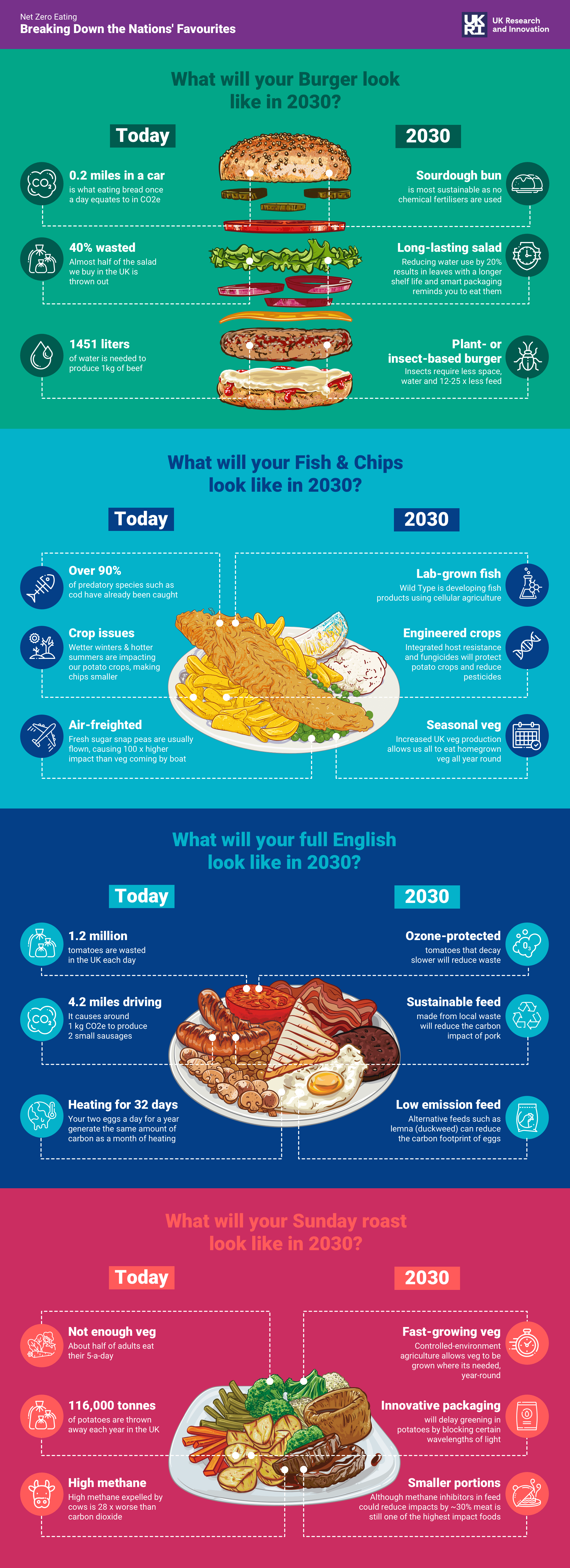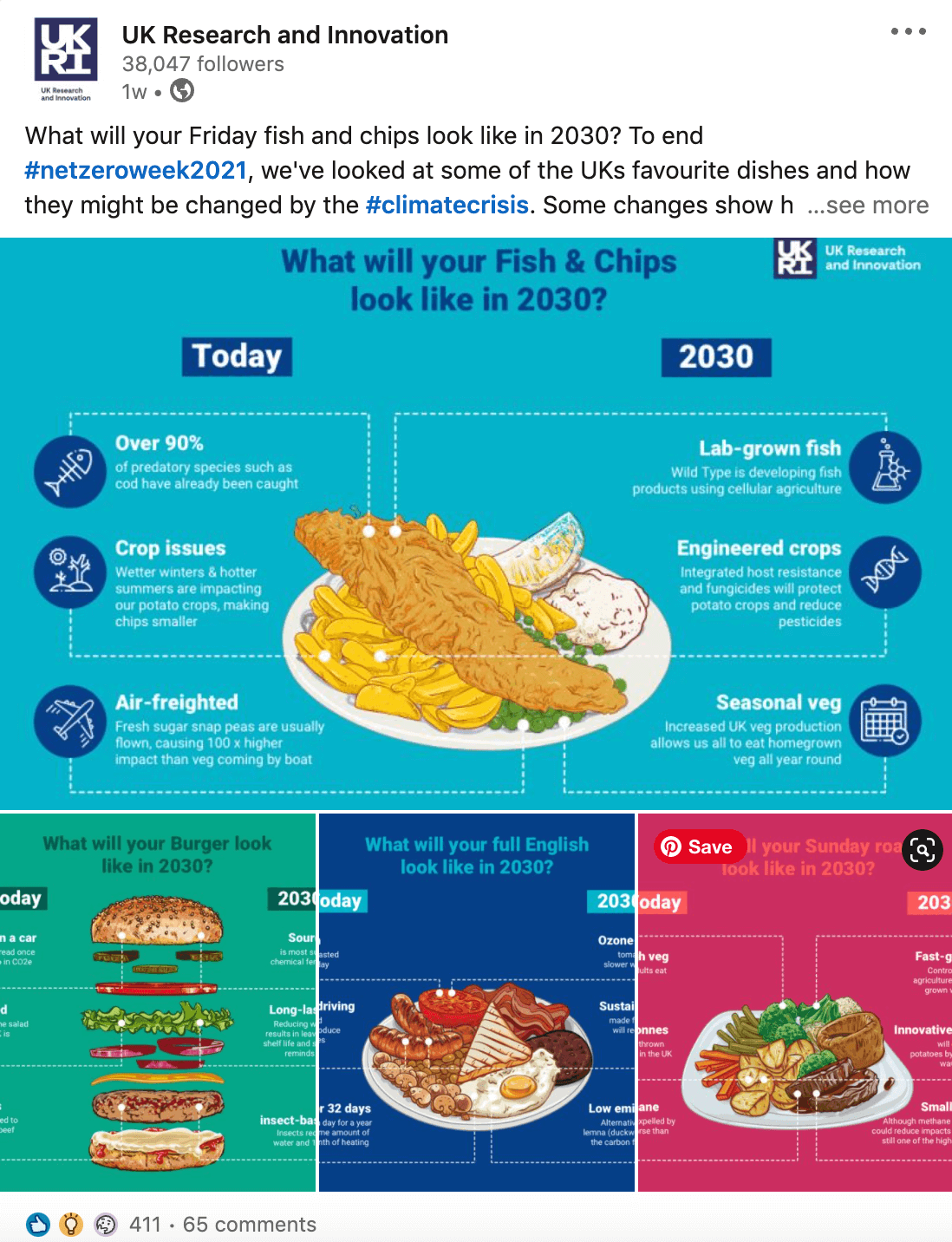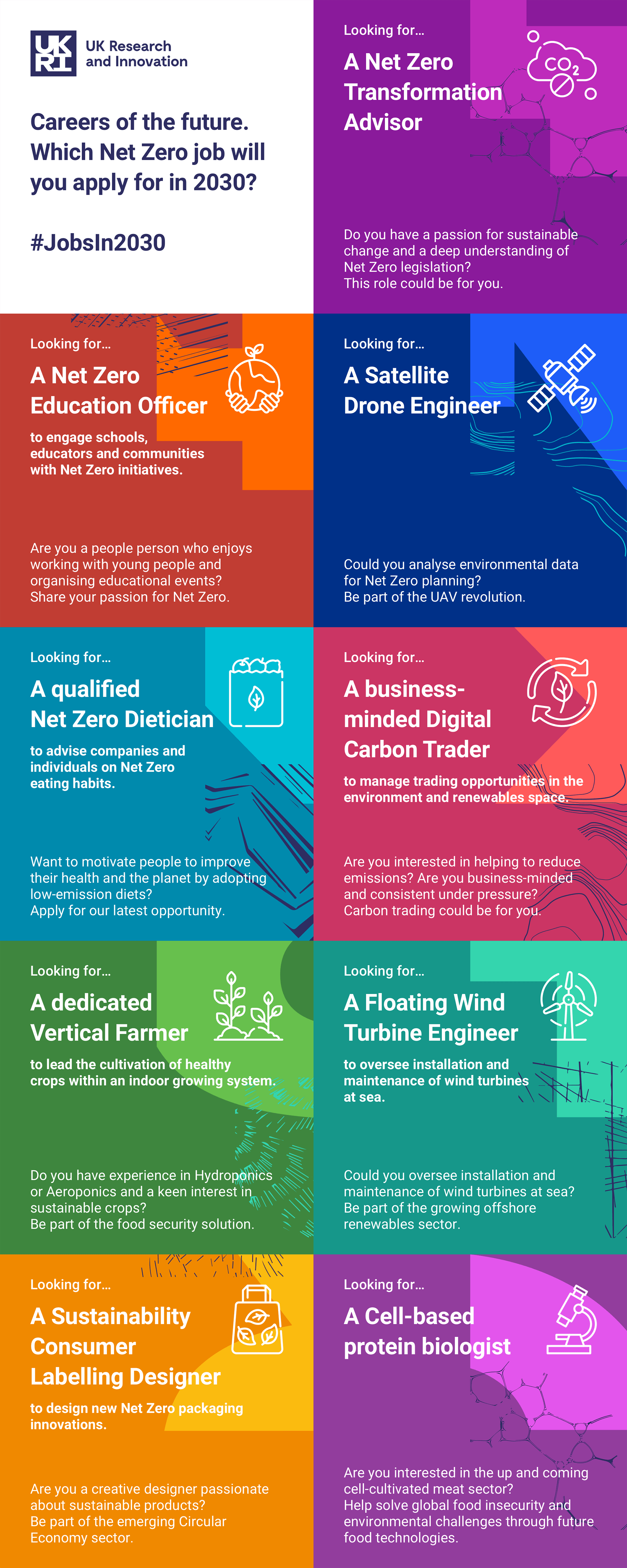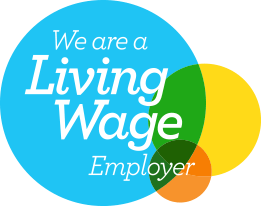05 Aug 2021
How will we Eat and Work in a Net Zero Future?
The UK is on the cusp of huge economic change fuelled by the departure from the EU, the ongoing COVID-19 recovery and the transition towards a Net Zero future. The Net Zero emissions target, which includes creating two million “green-collar” jobs in the UK by 2030, will transform how we create wealth, how we work and how our food is sourced and grown. It’s safe to say, 2030 will look very different.
To celebrate Net Zero Week 2021 and look ahead to COP26, UK Research and Innovation (UKRI) commissioned us to visualise future careers and eating with a range of infographics. So, how will we eat and work in a Net Zero future?
Net Zero Eating
Growing, making, transporting, storing and cooking our food is an energy-intensive process, generating huge amounts of greenhouse gas emissions that contribute to climate change. All in all, food is estimated to account worldwide for 31% of greenhouse gas emissions.
The recently published National Food Strategy, an independent review carried out for the UK government, breaks this down for us;
- The global mass of farm animals is now 22 times heavier than all wild animals combined
- Around 50% of Earth’s habitable land is used for agriculture, of which 77% is used to graze animals or to produce crops to feed to animals
- Agriculture – especially beef farming – is still the main cause of land-use change, including tropical deforestation
- Farming, hunting and fishing are the principal causes of species decline in Europe
- Global farming productivity is already 21% lower than it could have been without climate change
- The UK’s land footprint for food is 140% of the size of the UK
Some changes show how the research supported by UKRI, can help us produce our food in a more climate-friendly way.
We also know that the way we eat needs to change. We looked at Net Zero Eating as part of our work with UKRI. How could our favourite dishes be changed by the climate crisis?
Breaking Down the Nations’ Favourites
This is how we visualised our favourite meals in 2030…

What will your burger look like in 2030?
Plant or Insect-Based Burger
In 2030 we could be eating low emission insect burgers;
- Insects require less space, water and 12-25 x less feed than cattle to produce the equivalent amount of protein
- Bug Farm Foods has created VEXo – a minced meat replacement protein made from insects with over 80% reduced saturated fat
Sourdough Bun
In 2030 we could be eating more sourdough;
- Home-made sourdough is one of the most sustainable options as no chemical fertilisers used in producing commercial wheat and yeast are needed
Long Lasting-Salad
In 2030, we could be eating longer-lasting salad leaves;
- Research has shown that reducing water use by 20% when growing salad results in smaller, tougher leaves with a longer shelf life.
What will your fish and chips look like in 2030?
Lab-Grown Fish
In 2030, we could be eating lab-grown fish;
- In 2030, blockchain could help give consumers more visibility into where their fish comes from. We could soon see QR codes on fish products to track their provenance and sustainability.
- In 2030 we could be eating lab-grown fish. Start-up Wild Type is developing salmon products using cellular agriculture. Removing the need for fishing or farming
Engineered Crops
In 2030, we could be eating engineered potato crops to reduce waste;
- A Horticulture and Potato Initiative (HAPI) project successfully integrated host resistance and fungicides to protect potato crops and reduce the need for pesticides
- A Horticulture and Potato Initiative (HAPI) project used genetic engineering techniques to reduce pre-and post-harvest losses in potatoes
Seasonal Veg
In 2030, we could be eating more seasonal or dried vegetables;
- Increased UK veg production will allow us to eat home-grown veg all year-round
- Dry imported peas have less impact than fresh as they are transported by sea or road rather than air.
What will your full English look like in 2030?
Ozone-Protected Tomatoes
In 2030 we could be eating ozone-protected fruit;
- New research shows that ozone can protect fruit like tomatoes from decay for weeks after exposure – leading to less waste (Funded by NERC)
Sustainably Fed Pork
In 2030 we could be eating more sustainably fed pork;
- Swapping to more sustainable pig feed made from locally available waste products will reduce the carbon impact of pork
Low-Emission Fed Hens
In 2030, hens could be fed more sustainable feed;
- Alternative feeds such as Lemna (duckweed) can reduce the carbon footprint of eggs
What will your Sunday roast look like in 2030?
Faster-Growing Veg
In 2030 we could be eating faster-growing veg;
- Controlled-environment agriculture allows veg to be grown where it’s needed year-round
Innovative Potato Packaging
In 2030, innovative packaging could reduce potato waste;
- New packaging that delays greening in potatoes by blocking certain wavelengths of light could help reduce the number of potatoes thrown away (Funded by BBSRC)
Smaller Portions of Meat
In 2030 cows could be wearing emission-blocking masks and we could be eating smaller portions of beef;
- UK company Zelp has created a burp-catching mask for cows, designed to reduce methane emissions from cattle by 60%
- Although methane inhibitors in feed could reduce impact by around 30%, meat and in particular, beef, is one of the highest impact foods.
Net Zero Eating: Social Media Engagement
Our infographic on ‘foods of the future’, as shown below, had a profound impact on UKRI’s social network. It was the most engaged post on their LinkedIn page, amounting to an impressive 411 likes and 65 comments.

What will the Jobs of the Future be?
The UK has helped new green industries to develop, fuelling jobs and growth and the energy sector plays a vital part in helping the UK to make a transformational change to meet our emissions target. But to deliver on this ambition, we need to build a Net Zero Energy Workforce. A workforce with the talent, drive and passion to help us to transform the energy industry to create a greener, cleaner future.
“Green Collar” Jobs
Hundreds of thousands of opportunities will open up around the country and will require a diverse mix of skills, from scientists and engineers to communications professionals and data specialists.
It’s estimated that the Prime Minister’s ambitious Ten Point Plan for the ‘green industrial revolution’ will support up to 250,000 highly skilled green UK jobs by 2030. This includes supporting 60,000 jobs in offshore wind, 40,000 new jobs in zero-emission vehicles, and 50,000 jobs in greening the UK’s buildings. This represents the first steps towards our broader ambition of supporting 2 million jobs in the green economy and its supply chains by 2030.
Net Zero Jobs
Here are nine jobs UKRI predicts your company will need by 2030…

Net Zero Transformation Advisor
Responsibilities…
- Provide consultancy advice on meeting Net Zero targets
- Help clients align policies to Net Zero legislation
- Communicate Net Zero policies, processes and procedures to clients and stakeholders
- Provide education and training
- Work collaboratively with wider team and stakeholders
- Supporting the delivery of environmental strategies
Net Zero Education Officer
Responsibilities…
- Research and develop educational programmes and resources for schools
- Promote educational programmes
- Liaise with colleagues, teachers and community groups on the design and delivery of educational programmes
- Give talks in schools or to community groups on environmental issues
- Organise events and activities
- Draft environmental education policies and strategies
Drone Satellite Engineer
Responsibilities…
- Oversee environmental projects
- Analyse satellite data for different environments
- Collect and communicate data
- Drone maintenance and repair
Net Zero Dietician
Responsibilities…
- Online and/or face-to-face consultations with corporate clients
- Provide advice on diet and eating habits for Net Zero
- Motivate clients to adopt more sustainable ways of eating
- Keep up to date with the latest research and data on Net Zero eating
Digital Carbon Trader
Responsibilities…
- Manage trading opportunities in the environmental space
- Analyse renewables markets
- Develop carbon market analysis and modelling
- Ensure trading activity complies with risk governance policies and procedures
Vertical Farmer
Responsibilities…
- Growing edible leaves and soft fruits
- Analysing yield and crop quality
- Diagnosing and solving crop health issues
- Maintaining equipment
- Improving cultivation efficiency
- Data collection
Floating Wind Turbine Engineer
Responsibilities…
- Offshore turbine services such as repair and troubleshooting
- Maintaining health and safety procedures
- Monitoring and inspection for structural analysis
- Overseeing installation and maintenance operations
Sustainability Consumer Labelling Designer
Responsibilities…
- Design sustainable packaging innovations
- Support branding and marketing efforts
- Stay up to date with the latest in sustainable packaging research
A Stem-Cell Biologist
Responsibilities…
- Cultivate cells to replicate popular meat and fish products
- Ensure optimum temperatures, PH levels and conditions for growing maturity
- Improve processes to increase quality and efficiency
By changing our behaviour and expectations to make healthy, sustainable food choices and eating greener and cleaner, we can all play our part in helping the UK to reach its Net Zero target.
Visual communication is a vital element in delivering digital growth for our clients. If you’d like us to help produce and design an engaging infographic for you – get in touch and let us breathe life into your story.






